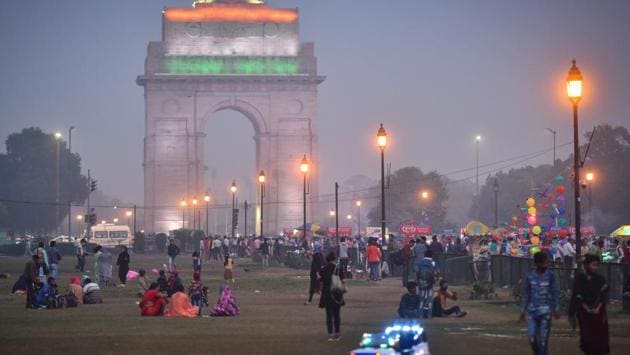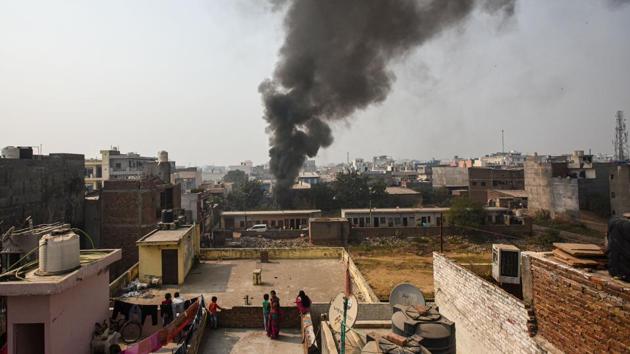Photos: SC asks Centre to ensure smog-free Delhi as AQI now “severe”
Updated On Nov 07, 2020 06:04 PM IST
Air quality in Delhi remained in the "severe" category for a third straight day on November 7 due to increased stubble fires and vehicle emissions, SAFAR, India’s main environment monitoring agency said. The central government's Air Quality Early Warning System for Delhi said the city's air quality is likely to remain "severe" on Diwali as well. This comes just a day after the Supreme Court asked the Centre to ensure that Delhi is rid of smog at the earliest and a blanket ban on the sale and use of firecrackers imposed by the state government came into effect.
1 / 8

Updated on Nov 07, 2020 06:04 PM IST
People at India Gate during the evening amid smog and cold weather conditions in New Delhi. Delhi’s air quality index (AQI) continued to remain in the “severe” category on November 7 for the third consecutive day after entering the red zone for the first time this season on November 5. (Sanchit Khanna / HT Photo)
2 / 8

Updated on Nov 07, 2020 06:04 PM IST
Morning walkers out on a cold morning at Green Park in New Delhi on November 6. The Supreme Court meanwhile, asked the Centre on November 6 to ensure there is no smog in Delhi-NCR when it was informed that the Commission on Air Quality Management had been constituted and begun functioning, a day after the AQI stood at 450 in the “severe” category, the season’s worst so far. (Amal KS / HT Photo)
3 / 8

Updated on Nov 07, 2020 06:04 PM IST
Fishermen at work in the polluted waters of the Yamuna River on a smog-ridden day in New Delhi on November 7. According to Central Pollution Control Board (CPCB) data, the air quality plunged into the “severe” category on 24 occasions last year. In 2018, there were 20 such days and in 2017, there were nine days when the AQI levels remained in the red zone. (Biplov Bhuyan / HT Photo)
4 / 8

Updated on Nov 07, 2020 06:04 PM IST
A plume of smoke rises from a fire in plastic waste in New Delhi on November 6. Scientists at the India Meteorological Department (IMD) told HT that the rising number of stubble burning cases in the neighbouring states of Punjab and Haryana has been the primary factor behind the Capital’s foul air -- contributing to 21% of Delhi’s PM 2.5 levels on November 6. (Amal KS / HT Photo)
5 / 8

Updated on Nov 07, 2020 06:04 PM IST
Commuters in the capital on the evening of November 6. According to the winter segment of the Graded Response Action Plan (GRAP), Delhi will enter the “severe plus” or “emergency” zone if PM 2.5 levels constantly remain above the 300ug/m3 and PM 10 levels stay above 500ug/m3 for at least 48 hours. IMD data for November 5 night, showed that the PM 2.5 levels had started improving and reached below the 300ug/m3 mark. (Raj K Raj / HT Photo)
6 / 8

Updated on Nov 07, 2020 06:04 PM IST
A volunteer displays a placard as a part of a Delhi government initiative urging commuters to switch-off the ignition of their vehicles at red lights, in New Delhi on November 5. According to GRAP, under the severe plus category, the CPCB task force can direct state governments in Delhi-NCR to stop the entry of all but essential trucks into Delhi, halt construction activity and implement the odd-even policy. (Jewel Samad / AFP)
7 / 8

Updated on Nov 07, 2020 06:04 PM IST
Customers shop for green crackers at a shop in New Delhi on November 5. Chief minister Arvind Kejriwal had on November 5 also announced a blanket ban on the sale and use of fireworks, including those of the “green varieties,” in the capital till November 30, in a bid to check Delhi’s rising pollution levels. Penalties up to ₹1 lakh have been announced for violators. (Raj K Raj / HT Photo)
8 / 8

Updated on Nov 07, 2020 06:04 PM IST



